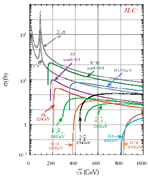Physics
The only missing ingredient of the Standard Model is the Higgs boson that gives masses to all the fundamental particles. Its discovery and detailed studies are the most urgent experimental task in present high energy physics. The recent precision electroweak data put an upper limit on the Higgs boson mass to be about 200 GeV at the 95% confidence level, strongly suggesting the existence of a light Higgs boson.
One of the most exciting possibilities is the discovery of the Higgs boson with a mass of less than 150 GeV. This mass range is particularly interesting from the viewpoint of grand-unified models with the grand-desert hypothesis. It also fits more naturally in Supersymmetric extensions of the Standard Model than in the Standard Model itself.
Once such a light Higgs boson is found, the most important question is whether the observed Higgs boson is of the Standard Model or not. The JLC will answer this question through systematic studies of its decay properties, precision branching ratio measurements in particular. These detailed studies are possible only with a high luminosity and a clean environment of lepton colliders.
Even more exciting is the discovery of supersymmetric particles or some hints of extra dimensions. Their precision studies would open up a completely new era of high energy physics, that might lead us to a unified picture of all the matter and forces, and even space-time as well.
It should be emphasized, however, that even in the absence of any direct indications of new physics, there remain many important measurements to be made regarding W/Z boson properties, QCD, and two-photon physics. It is then of vital importance to further improve the precision of the data from the existing large-scale experiments in the world, so as to find any indirect indications of physics beyond the Standard Model.
 |
| Physics Target
|
Notice also that, although the top quark has already been discovered at Tevatron and studied to some extent, its detailed study at the JLC will shed a totally new light on the heavy quark dynamics. Since QCD effects remain well under control, the study enables us to extract other smaller effects such as the Higgs exchange contribution: the first observation of the top Yukawa coupling.
The experiments at the JLC will thus bring us to a deeper understanding of nature and possibly open up a way to uncover the secrets of the creation and evolution of our universe.
